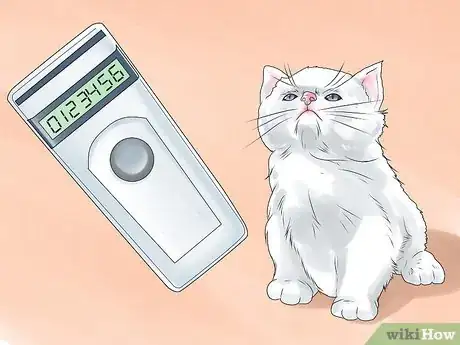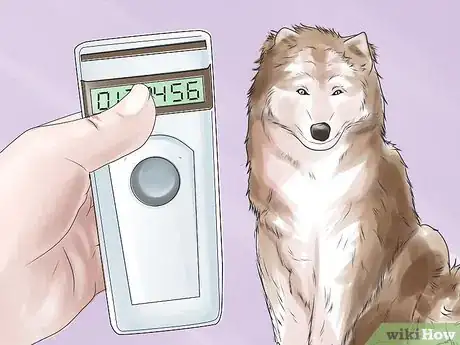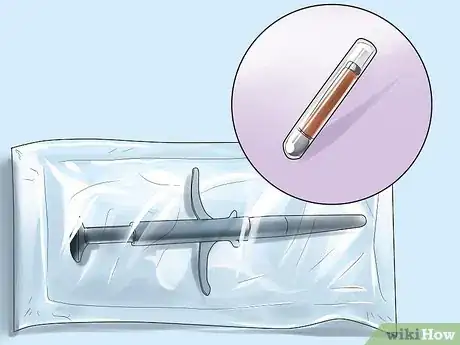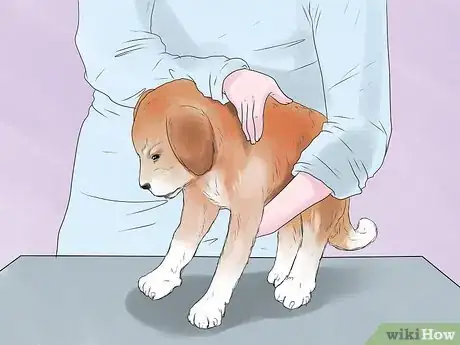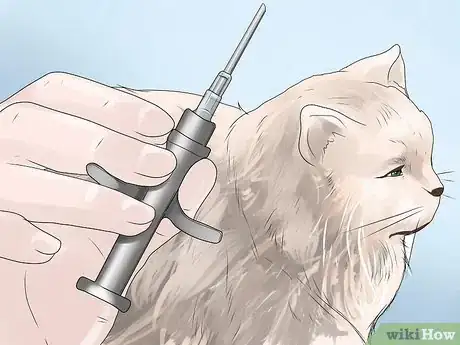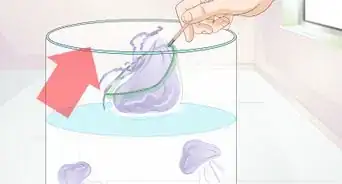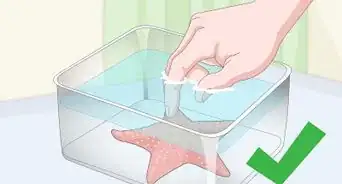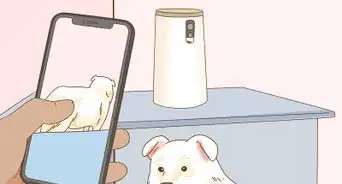X
wikiHow is a “wiki,” similar to Wikipedia, which means that many of our articles are co-written by multiple authors. To create this article, volunteer authors worked to edit and improve it over time.
This article has been viewed 41,344 times.
Learn more...
Pets may be chipped to prove ownership of an animal, for export certification, or by a rescue shelter to discourage pet abandonment. Implanting an identification microchip is quick and easy to do. Some animals may experience momentary discomfort as the needle housing the chip enters the skin, so it is a good idea to restrain any animal having a chip implanted.
Steps
Part 1
Part 1 of 2:
Preparing the Animal and the Microchip
-
1Gather the necessary equipment and materials. To inject a microchip you will need:
- A microchip scanner: Microchips are not completely standardized. This means that not all chips respond to the same frequency scanner. You need a scanner that is compatible with the make of microchip about to be implanted. Whereas Europe mainly uses chips that are "duplex" compatible, in the US mainly "AVID" and "destron" devices are used.
- A microchip: This should be sealed in sterile packaging. The chips come with an individual, single use implantation syringe. If the packaging is breached do not use the device because sterility may be compromised.
- An assistant: In a docile, compliant dog or cat, or an animal under anesthetic, it is perfectly easy to implant a chip single-handedly. However, the needle causes momentary discomfort and many animals flinch. An assistant restraining the patient ensures the procedure is safe and makes implantation quick and easy.
- Cotton wool soaked in surgical spirit: To sterilize the skin.
- The animal: The animal to be chipped.
-
2Pre-scan the animal. It may sound obvious, but it is essential to scan the animal about to be chipped. This is to check the pet isn't already microchipped.
- If a chip is found this eliminates the need to go through with the procedure. In addition, it should raise questions about why the pet is being presented for a chip when it is likely he already has an owner.
- To check for a chip it is necessary to pass the scanner over the animal in a logical search pattern to ensure a chip that has slipped or migrated from its original implant position is not missed.
Advertisement -
3Follow the correct scanning pattern. Microchips are implanted under the skin, over the midline of the spine, between the shoulder blades. However, not all chips remain in this spot and movements of the animal during normal activities can cause the chip to migrate and change location.
- Activate the scanner by pressing and holding down the button. Rest the sensor on the underside of the scanner softly against the animal's fur, or hover 1–2 inches (2.5–5.1 cm) above the skin.
- Start with the scanner positioned behind the pet's ears and move left to right, right to left, in a sweeping motion over the animal's neck. Progress in this side to side sweeping motion down the neck, over the shoulders, and to the end of the rib cage.
-
4Do a final sweep. If no chip is detected, sweep again but this time run the scanner up and down the length of the animal.
- Start in front of the left elbow in the brisket area, slide the scanner back along the chest and tummy, then sweep forwards towards the shoulder.
- Repeat this pattern until you have surveyed the animal's entire body. Only then can you be certain no chip is present.
-
5Prepare the microchip. Once satisfied the animal is not already chipped, prepare the microchip. The chip is stored inside a sterile hypodermic needle attached to an implantation device.
- The needle should be inside sealed packaging. On the packaging are stickers with a bar-code and a unique registration number.
- Pass the scanner over the needle (while it's still in the packaging) to check the chip is firing, and to get the chip's number. Compare the scanned number with that shown on the packaging. The two should match.
- Peel the backing from the packaging but leave the implantation device resting in the pack. Place it within reach.
Advertisement
Part 2
Part 2 of 2:
Injecting the Microchip
-
1Restrain the animal. Small dogs and cats are best held on a table. Large dogs can be restrained on the floor. When dealing with a dog of uncertain temperament it is best to muzzle him, to ensure operator safety.
- Cats: Place the cat on a table. Let the cat sit comfortably and have the assistant firmly grasp the cat's scruff so as to prevent the cat from turning and biting.
- Small Dogs: Stand the dog on a table. Have the assistant stand on the opposite side to you, and slide one arm under the dog's neck and place the hand over the dog's ear such that the head is held against the assistant's chest or shoulder. Slide the other arm under the dog's belly with the hand resting on the dog's back so as to pull the body against the chest and stop the dog from sitting down.
- Large Dogs: With the dog standing on the floor, the assistant stands behind the dog's head and places a hand on either side of the head, to keep the dog facing forwards.
-
2Swab the animal's skin. Although the implantation needle is sterile, there is a small risk of pushing bacteria from the surface of the skin into the subcutaneous tissues when the needle is inserted. To prevent this, it is best to swab the area first with surgical spirits.
- To do this, you should first plan where to place the needle. This is usually midline over the backbone, between the shoulder blades.
- Soak a cotton ball with surgical spirits and wipe this over the skin until the fur is well dampened down.
-
3Lift the scruff. The chip needs to be implanted beneath the skin and to do this without damaging muscle, tendons, or bones, the scruff is raised up.
- If you are right handed, use your left hand to grasp a fold of skin two inches in front of where you plan to place the needle.
- Holding the skin firmly between forefinger and thumb, lift this fold of skin vertically away from the body, to the fullest extent the skin comfortably allows without pulling.
-
4Inject the microchip. With the scruff still elevated, pick up the installation device and place the needle at a right angle to the flat plain of the elevated scruff.
- Hold the device so that the length of the syringe is parallel to the spine and the needle is pointing towards the head. Once satisfied with the needle location, use firm pressure to push the needle through the skin right up to the needle hub.
- With the needle deeply embedded through the skin, press the plunger of the implantation device to push the microchip out of the needle and into position beneath the skin.
-
5Withdraw the needle. When the needle is withdrawn from the skin, the needle tract does not contract instantaneously. As a result, there is a slim chance that the microchip slips back out of this tract immediately after implantation.
- This is easily avoided by applying pressure across the needle as it is withdrawn. This pressure sticks the edges of the needle tract together and prevents backward migration of the chip.
- To do this, once the microchip is implanted, release the scruff. Using the finger and thumb of the left hand, feel through the skin for the rigid needle.
- Press gently but firmly across the width of the needle as the right hand withdraws it. Keep pressing for 10 seconds or longer, after the needle is out. Then release.
-
6Check the chip. The final step is to check that the chip is in place and working. Activate the scanner and hold it over the area of implantation. If all has gone well, the chip should register strongly on the scanner.
- Occasionally the chip does not respond, but because you know the chip worked in the packaging, it is unlikely that the chip is at fault.
- The more likely explanation is that the chip failed to exit the needle (scan the needle) or has fallen out on the floor. If this is the case, you will need to repeat the procedure with a fresh chip.
Advertisement
Community Q&A
-
QuestionHow do I tell if my pet already has a microchip?
 Community AnswerGo over the pet with a scanner, as described above. You can also take your pet to the vet and they will be able to determine whether or not a microchip has already been placed in the pet.
Community AnswerGo over the pet with a scanner, as described above. You can also take your pet to the vet and they will be able to determine whether or not a microchip has already been placed in the pet.
Advertisement
References
About This Article
Advertisement
